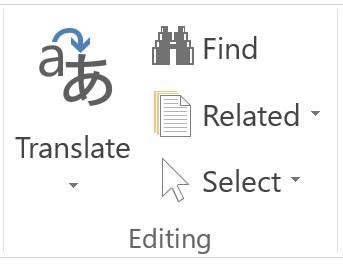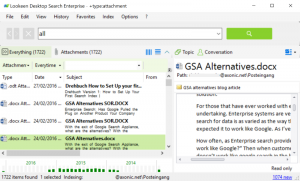Using Full Text Search
When you use full text search, the search engine you are using will examine every single word in every document you have stored, and will try to match the search criteria to the content of the document. There are many business scenarios where full text search can come in handy: E-businesses are a great example of using this technology online, because most customers will use search bars to find items they need. A law firm requires searches to be able to pick up on small details within large case history databases. Doctors need an easy way to search for patient records by various key terms. No matter the business, full text search can be narrowed down to fit specific needs. These queries are not case sensitive, so whether you type things in with lower case or upper case letters, the results will be the same.
Full Text Search in Outlook
With work comes large volumes of email, and by the end of the day, trying to remember which email said what, is a futile task. This is when the ability to do a full text search in your Outlook Inbox will save you time and a world of frustration. There are a couple of different instances where a it can be the productivity boosting function you need:
Search in a Specific Email
In Outlook, if you have been trying to figure out how to find a certain word or string of words in a long message, you can do so, but not from the reading pane. The standard Ctrl+E Outlook search won’t help in this instance – You will need to open that email in a separate window to search for the specific words within the content of the message.
From here it’s actually quite simple:
- At the very top of the email, under the ‘Editing’ section of the Message ribbon, look for an icon in the shape of little binoculars and the word Find to the right of the icon.
Click on Find to open a small window called “Find and Replace”. This is where you can type in the word or string of words that you need to locate within the Outlook email.

- You can also quickly open this window using the Ctrl+Shift+F shortcut.
Note that this tool is to find text within one specific email, usually one with a large amount of text. There is another tool you can use if you need a full text search done on a number of emails in your inbox:
Outlook 2010: Body Search Property
You can search for certain information or words within the text or bodies of emails by adding the Body property to your search. To find this, click in the search bar to open the Search tab in the ribbon, and find the Plus icon with the word ‘More’ to the right of it. When you click on this, a drop down menu will appear with quite a few options to refine your search. Click on the option that says Body, which will now allow you to do a full text search of the bodies of emails from within your inbox.
In more recent versions of Outlook, this property is included by default in the search.
What about search within Attachments?
The question about full text search in Outlook most commonly asked is “Can the Outlook Search tool search for text within an attachment such as a PDF file?” The answer is both yes and no. To clarify: Outlook search can search within attachments, but it can’t read every single file type by default. You need to have the corresponding iFilter installed. Outlook can index over 200 common file types already. PDFs are indexed, but only by name unless you have the right PDF ifilter installed.
Full text search isn’t Outlook’s strongest point, but you can make it work for you if necessary. Still, you do have the option of looking for a stronger search tool, like Lookeen, that can give you more comprehensive search results in a matter of seconds. It’s important to save time when it comes to your productivity and what better way to do so then with a stronger and more reliable search tool?



Leave a Reply